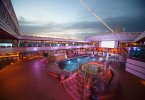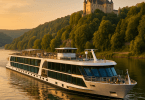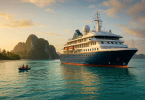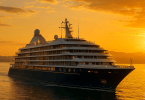As awareness of climate change grows, cruise lines are investing heavily to reduce their environmental footprint. For years, the conversation centered on whether large vessels could ever be eco friendly. Now, thanks to advances in propulsion and design, we are entering an era when zero‑emission cruising is no longer just an aspiration.
Viking made headlines this year when it ordered the world’s first hydrogen‑powered cruise ship. The 998‑guest Viking Libra, being built by Fincantieri, will feature 499 staterooms and use liquefied hydrogen fuel cells to provide both propulsion and onboard electricity. Scheduled for delivery in late 2026, the ship will operate at true zero‑emissions when running on hydrogen. CEO Torstein Hagen said the decision to invest in fuel cells reflects Viking’s commitment to “investigating the next generation of shipbuilding,” while Fincantieri’s CEO Pierroberto Folgiero noted that such projects mark a major step forward for sustainable maritime transport. A sister vessel, Viking Astrea, is expected in 2027.
The hydrogen concept builds on other green initiatives already being deployed. Many new luxury and expedition ships are powered by hybrid systems that combine liquefied natural gas (LNG) with battery storage, allowing them to operate on electric power when docking in sensitive areas. Others are equipped for shore‑side power connections, enabling them to shut down engines and run on local renewable electricity while in port. Across the industry, single‑use plastics are being eliminated, advanced wastewater treatment systems are becoming standard, and menus increasingly feature sustainably sourced seafood and locally produced provisions.
At the small‑ship end of the market, lines like Ponant and Silversea have committed to carbon neutrality and are partnering with scientific organizations to conduct research on board. Ponant’s newest polar vessels incorporate energy‑saving designs such as ice‑breaking bows, waste‑heat recovery systems and dynamic positioning that eliminates the need for anchors in fragile seabeds. Silversea’s Nova‑class ships will feature hybrid power plants that use LNG, fuel cells and batteries, cutting emissions by up to 40 percent compared with traditional luxury ships. These investments align with growing guest demand for voyages that tread lightly on the planet without sacrificing comfort or service.
For river cruises, electrification is advancing rapidly. Several European lines now operate battery‑powered vessels on shorter itineraries and are experimenting with solar panels integrated into sun decks. In Asia, hybrid electric‑diesel boats ply the Mekong and Irrawaddy, reducing noise and emissions in communities where the river is both highway and lifeline. While these technologies are not yet widespread, they signal how quickly innovation is moving.
Expert Insight: Sustainable cruising is evolving from peripheral marketing message to core strategy. Viking’s hydrogen‑powered Libra demonstrates that zero‑emission ships are technically feasible and commercially viable. Affluent travellers who want to align their vacation choices with their values should look for lines that prioritize alternative fuels, shore power capability and transparent environmental reporting. Early adopters will not only reduce their own footprint but also encourage further investment in the technologies that will define the future of cruising.








